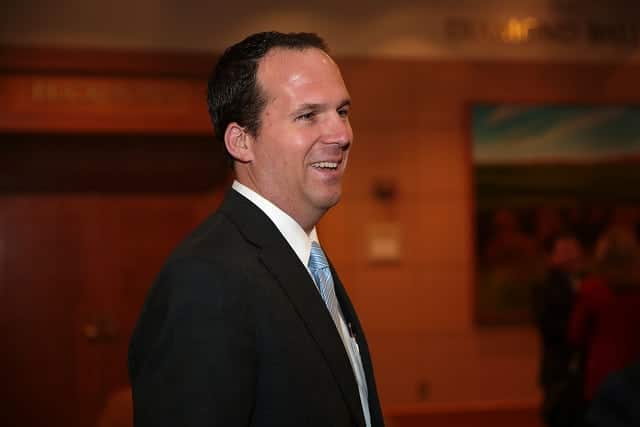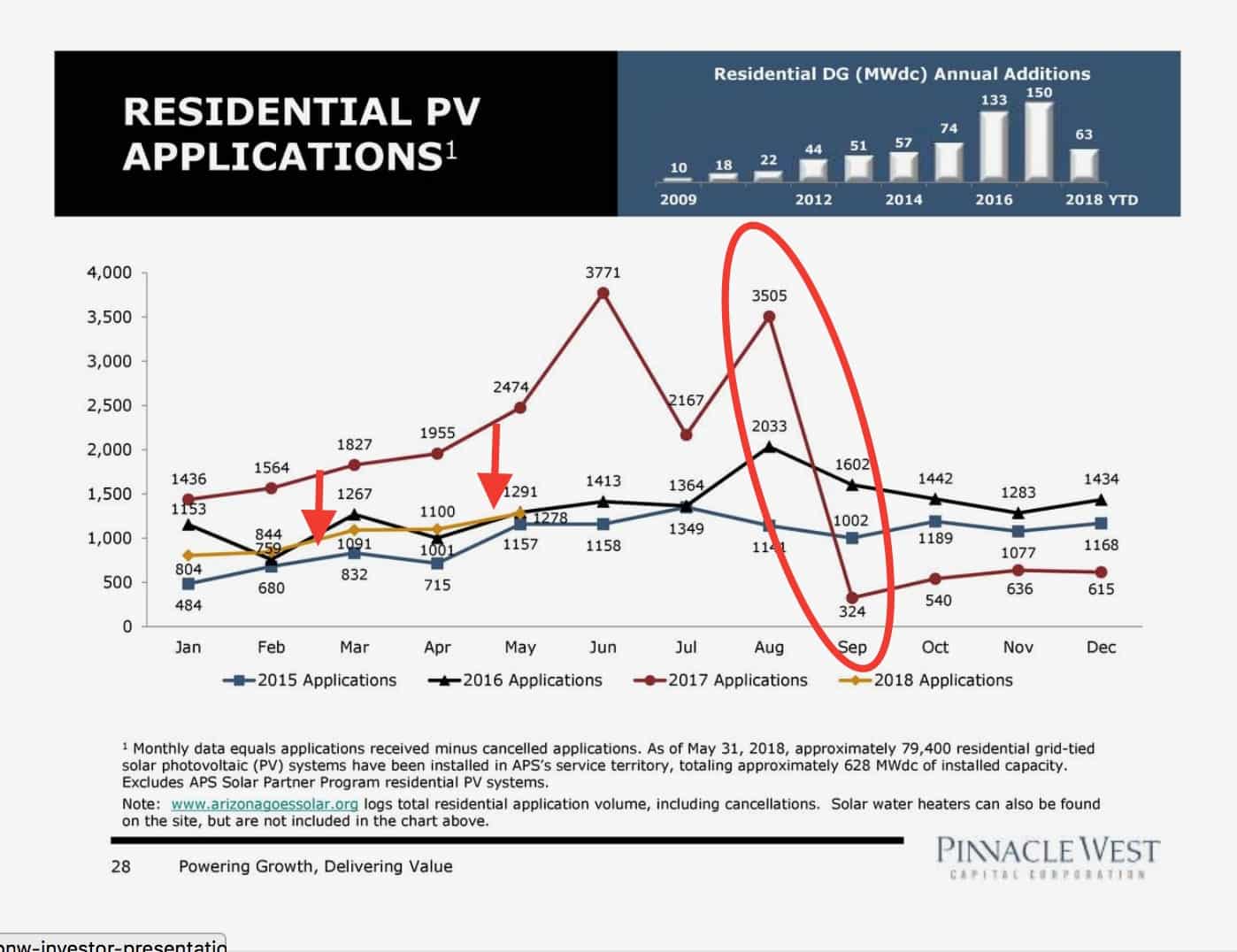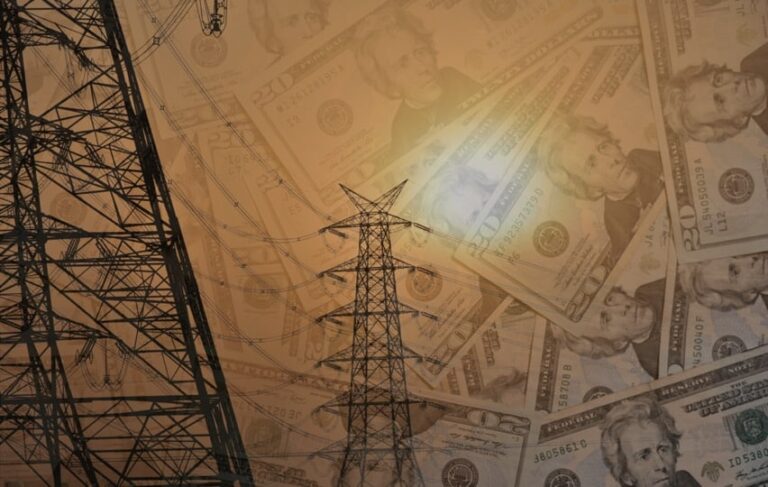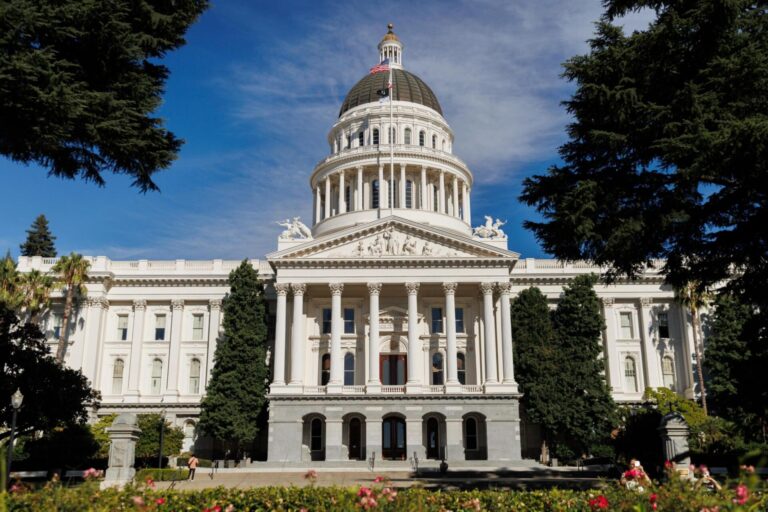Arizona Commissioner Justin Olson answered questions about Arizona’s energy policy by copying parts of an APS memo verbatim, emails show

Arizona Corporation Commissioner Justin Olson based his responses to wide-ranging questions about Arizona’s energy policy on a private memo provided to him by Arizona Public Service, the state’s largest monopoly electric utility and the company that Olson is supposed to regulate.
The questions came in a public phone interview that Olson held with a Wall Street investment analyst from the firm Credit Suisse in May of this year.
Before the call, the investment analyst provided Olson with a list of the questions he would ask. Olson forwarded the analyst’s questions to a lobbyist from APS, requesting that the lobbyist “let me know if you guys have any insights that you would like to share prior to the call on any of these topics,” according to emails provided to the Energy and Policy Institute by the Corporation Commission in response to an Arizona Public Records Law request.
The lobbyist responded later that day with a 5-page memo detailing APS’ responses to the questions about controversial issues like rooftop solar power, the state’s renewable energy goals, coal-fired power plants, energy efficiency, nuclear power and electricity demand growth. On the call with the Credit Suisse analyst, Olson appeared at times to read directly from the policy memo as he repeated APS’ answers verbatim.
The emails, which also include some exchanges between APS lobbyists and Commissioners Andy Tobin and Tom Forese, are available here.
APS lobbyist, a former ACC staffer, was Olson’s source for policy questions
Michael Weinstein, an analyst from Credit Suisse who writes about investor-owned utilities, conducted the May 18 interview with Olson. Analysts like Weinstein help form Wall Street’s opinion about whether investors should buy or sell utility stocks. They frequently interview state utility regulators to ask for their perspectives on policy and regulatory questions, since the regulators’ decisions are crucial in determining just how much the utilities will be able to profit. The call was open to the public, and EPI has posted a recording of it here. A transcript is available here.
At 8:58 a.m. on May 17, the morning before the call with Weinstein, Olson emailed Amanda Ho, APS’ Director of State Regulatory Affairs and Compliance.
“Amanda, thanks for the call yesterday. Below is the list of potential questions that might be addressed on tomorrow’s call with credit Suisse. Let me know if you guys have any insights that you would like to share prior to the call on any of these topics,” Olson wrote, followed by the list of questions he expected from Weinstein.
Ho responded six minutes later: “I’ll have my team pull information/data and get that to you ASAP. Thanks!”
At 6:13 that evening, Ho sent Olson a five-page memo which she described as “background information/data and APS’s perspective of the questions you sent over this morning.” The document itself was titled “Commissioner Olson’s Background Questions: Draft Responses for your Consideration/Editing.”
Olson and Ho also exchanged text messages on May 17, which the Corporation Commission provided to EPI in response to a separate records request:
Olson texted: “Thank you for the phone call. I will check the email. I definitely agree with the points you were making on the voicemail. I’ll let you know in the morning if I have any questions. Thanks so much for putting together your guys’s thoughts on these questions. I appreciate the effort that was put into it.”
“Anytime Commissioner. Please let me know if you have any questions as you are going through the document,” Ho texted back.
Before joining APS in 2015, Ho had worked at the Commission as a staff attorney and policy advisor to two commissioners, Jeff Hatch-Miller and Bob Stump. Stump now runs a trade association for Arizona utilities.
Emails from March show Ho’s predecessor at APS, Greg Bernosky, introduced her to the Commissioners as “a great resource for you going forward.”
APS memo painted biased, utility-friendly picture on rooftop solar, efficiency
APS’ response was far from objective “information/data.” It was a restatement of APS’ policy preferences, some of which are highly controversial. Like most investor-owned monopoly utilities, APS has fought against policies that result in more people installing their own solar panels or using less electricity, because they make it less necessary for APS to build its own power plants and infrastructure, which is how it earns a profit.
APS’ memo to Olson said that customer-owned solar power is less cost-effective than utility-scale solar power that APS owns, a position that ignores the many benefits of distributed solar energy, including the obvious one that the money spent to install rooftop solar panels comes from private capital, rather than from APS’ customer base. The memo included other unqualified attacks on distributed renewable energy.
Olson’s remarks on the call lifted directly from APS’ policy memo in some of the following areas:
Rooftop solar vs. utility-scale solar
APS Memo: “From a cost perspective, utility scale solar today is approximately 1/3 the price to install relative to rooftop installations while providing the same environmental benefits. It also has benefits such as tracking that can provide more energy during peak periods on the system. However, some customers have shown the desire to exercise their energy choices and install rooftop solar to suit their individual needs.”
Olson: “The cost of installation is about a third of the cost of rooftop solar. In addition are added benefits of utility-grade solar that it can track with the sun throughout the day which increases the efficiency of the energy generation. So more energy can be produced during the peak periods on the system. These are some significant advantages of utility-grade solar. Now the advantage of rooftop solar is clearly that that many customers want to have rooftop solar on their houses. And I recognize that there is that desire.”
Elsewhere in APS’ memo, the company claimed that “the [distributed solar] marketplace is healthy in Arizona” even though, according to APS’ own data, distributed solar installations fell off a cliff after APS lobbied the ACC for a new rate structure, implemented last August, that made rooftop solar energy less economically attractive for customers.

A slide from a July presentation that Pinnacle West, APS’ parent company, made to investors in July shows the drop-off in solar installations.
Energy Efficiency
When Weinstein asked whether energy efficiency programs had made satisfactory progress, or needed to be expanded, Olson dictated from APS’ memo, which praised the utilities’ supposed progress on energy efficiency.
APS Memo: “Significant progress has been made on Arizona’s energy efficiency programs. Utilities have reconfigured their offerings to align with the way customers use energy with the focus now being on high-value DSM programs that address peak energy periods. Additionally, the toolbox for Demand Side Management is being expanded to include smarter or more efficient uses of energy as opposed to simply tracking kWh reductions.”
Olson: “You know I think that energy efficiency has been quite successful in Arizona at bringing down the demand. Significant progress has been made in these programs. Utilities have reconfigured their offerings to align with the way customers use their energy with the focus now being on the high-demand – the high-value demand side management that’s being executed and using smarter, more efficient technologies that are smarter than what historically has been using just simply tracking kilowatt hour reductions.”
The “significant progress” on energy efficiency as defined by APS entailed a dramatic recent reduction in spending on the issue. APS proposed to the ACC that it planned to cut its energy efficiency spending by 28% from 2017 to 2018, according to regulatory filings. On page 4 of the 2017 filing, APS says it spent $59 million to help customers use less electricity via energy efficiency in that year. It budgeted only $42 million on the same types of energy efficiency in 2018.
Should APS own utility-scale renewable generation, or should third parties?
Weinstein asked whether Olson and the Commission preferred “rate-based” generation assets or “power purchase agreements.” A rate-based generating asset would be a gas-burning power plant or solar farm that APS builds and owns. In that case, the utility gets to collect a profit, usually of about 10 percent. In a power purchase agreement, a third-party developer builds the generating asset and sells the electricity to APS. Monopoly utilities like APS do not collect the same profit in that scenario, so they prefer rate-based assets. Power purchase agreements tend to be cheaper for customers, however.
APS’ memo suggested that Olson defer the question to the Commission’s process for evaluating Arizona’s long-term plan, or “Integrated Resource Planning” (IRP), which Olson dutifully did.
APS Memo: “Future resource levels are best addressed through the IRP process. However, it is important that a significant portion of generating resources be owned, maintained and operated by financially healthy utilities as a means to ensure efficient and reliable operation of the electric grid.”
Weinstein: “Maybe give us an idea of the debate within the commission or maybe your own feelings on purchase power agreements versus rate-based generation assets… ”
Olson: “You know I think that those discussions are best dealt with in our IRP process. I think that it’s important for us to look at the totality of the plan, what our utilities are looking to do to meet future demands on their systems and evaluate the entire approach to determine, you know, is this a balanced approach?”
Palo Verde Nuclear Power Plant
Olson copied APS’ talking points on its Palo Verde nuclear plant verbatim.
APS Memo: “Palo Verde is the largest carbon-free energy generating plant in the country, and the only resource in Arizona that provides continuous carbon-free energy day in and day out – every day.”
Olson: “It’s actually the largest carbon-free generating plant in the country which provides continuous carbon-free energy day in and day out – every day.”
Electric Load Growth
Weinstein asked Olson about Arizona’s economic growth and electric demand, a common question from investor analysts of utilities and their regulators. Higher economic growth historically correlates with increased demand for electricity. More efficient electricity use and adoption of distributed energy resources like rooftop solar are decoupling that relationship, but all utilities, including APS, try to paint rosy pictures of economic growth and electric demand growth so that they can justify building new power plants and other infrastructure that increase their profits.
Olson parroted many of APS’ talking points on Arizona’s economic growth and electric demand growth verbatim.
APS Memo: “These strong economic indicators are also translating into solid electric customer growth. APS’s retail customer growth in the last several quarters has been between 1.5% and 2.0%. [APS data].
“New customers also means increasing demand for electricity, but the increases from new customers have largely been offset by continued penetration of rooftop solar with existing residential customers and the impacts of the Company’s energy efficiency programs with existing residential and C&I customers. [APS data]”
Olson: “These strong economic indicators are also translating into solid electric customer growth. APS’ retail customer growth in the last several quarters has been between 1.5% and 2%. And these new customers mean increasing demand for electricity, but the increases from new customers have largely been offset by continued penetration of rooftop solar with existing residential customers and the impacts of the company’s energy efficiency programs with existing residential and commercial and industrial customers as well.”
Since the interview, Weinstein has written investor memos about APS in which he has cited his conversations with Olson to suggest that the Commission was likely to continue to treat APS favorably on a host of issues.
At times during his campaign, Olson has sought to publicly distance himself from APS. He has made the point repeatedly that he was not on the Commission when it granted APS a controversial rate increase in 2016, noting that “Public confidence in the commission and the broader election system we have has been shaken.” He has also touted his work to push for a reformed Code of Ethics for the Corporation Commission.
Photo credit for top image of Olson: Gage Skidmore



